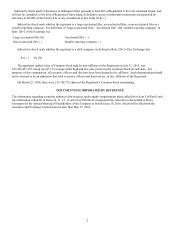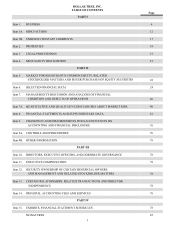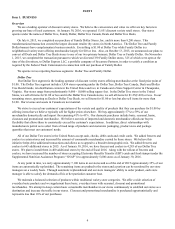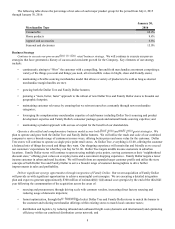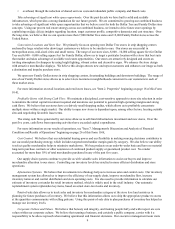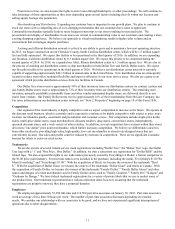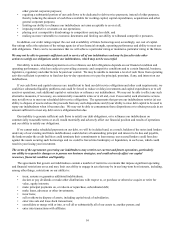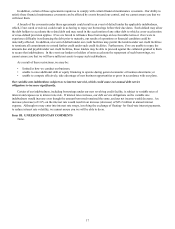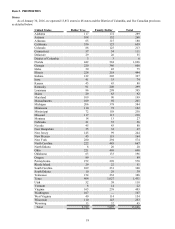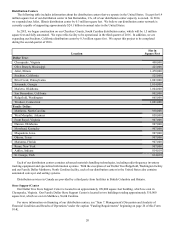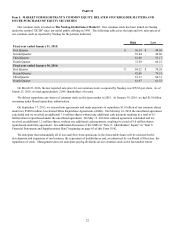Dollar Tree 2015 Annual Report Download - page 28
Download and view the complete annual report
Please find page 28 of the 2015 Dollar Tree annual report below. You can navigate through the pages in the report by either clicking on the pages listed below, or by using the keyword search tool below to find specific information within the annual report.12
Item 1A. RISK FACTORS
An investment in our common stock involves a high degree of risk. Any failure to meet market expectations, including our
comparable store sales growth rate, earnings and earnings per share or new store openings, could cause the market price of our
stock to decline. You should carefully consider the specific risk factors listed below together with all other information
included or incorporated in this report. Any of the following risks may materialize, and additional risks not known to us, or that
we now deem immaterial, may arise. In such event, our business, financial condition, results of operations or prospects could
be materially adversely affected.
Our profitability is vulnerable to cost increases.
Future increases in costs such as the cost of merchandise, wage and benefit costs, merchandise loss (due to theft, damage,
or errors), shipping rates, freight costs, fuel costs and store occupancy costs may reduce our profitability. The minimum wage
has increased or is scheduled to increase in multiple states and local jurisdictions and there is a possibility that Congress will
increase the federal minimum wage. The Department of Labor is expected to issue regulations this year that may result in
fewer of our associates being exempt from overtime pay requirements. In our Dollar Tree segment, we do not raise the sales
price of our merchandise to offset cost increases because we are committed to selling primarily at the $1.00 price point to
continue to provide value to the customer. We are dependent on our ability to adjust our product assortment, to operate more
efficiently or to increase our comparable store net sales in order to offset inflation or other cost increases. We can give no
assurance that we will be able to operate more efficiently or increase our comparable store net sales in the future. Although
Family Dollar, unlike Dollar Tree, can raise the price of merchandise, customers may buy fewer products because of a higher
price. Please see "Item 7. Management’s Discussion and Analysis of Financial Condition and Results of Operations" beginning
on page 26 of this Form 10-K for further discussion of the effect of Inflation and Other Economic Factors on our operations.
Integrating Family Dollar’s operations with ours may be more difficult, costly or time consuming than expected and the
anticipated benefits, synergies and cost savings of the Acquisition may not be realized.
The success of the Family Dollar acquisition (the “Acquisition”), including anticipated benefits, synergies and cost
savings, will depend, in part, on our ability to successfully combine and integrate the businesses and cultures of the Family
Dollar segment into our company. It is possible that the integration process will take longer than anticipated, and could result
in the loss of key employees, higher than expected costs (including costs incurred with respect to the divested stores and related
services), ongoing diversion of management attention, increased competition, the disruption of our ongoing businesses or
inconsistencies in standards, controls, procedures and policies that adversely affect our ability to maintain relationships with
customers, vendors and employees. If we experience difficulties with the integration process, the anticipated benefits of the
Acquisition may not be realized fully or at all, or may take longer to realize than expected. In addition, the actual cost savings
of the Acquisition could be less than anticipated.
A downturn in economic conditions could impact our sales.
Deterioration in economic conditions, such as those caused by a recession, inflation, higher unemployment, consumer debt
levels, cost increases, as well as adverse weather conditions or terrorism, could reduce consumer spending or cause customers
to shift their spending to products we either do not sell or do not sell as profitably. Adverse economic conditions could disrupt
consumer spending and significantly reduce our sales, decrease our inventory turnover, cause greater markdowns or reduce our
profitability due to lower margins.
A significant disruption in our computer and technology systems could adversely affect our results of operation or
business.
We rely extensively on our computer and technology systems to manage inventory, process credit card and customer
transactions and summarize results. Systems may be subject to damage or interruption from power outages, telecommunication
failures, computer viruses, security breaches and catastrophic events. If our systems are damaged or fail to function properly,
we may incur substantial costs to repair or replace them, may experience loss of critical data and interruptions or delays in our
ability to manage inventories or process customer transactions and may receive negative publicity, which could adversely affect
our results of operation or business.


